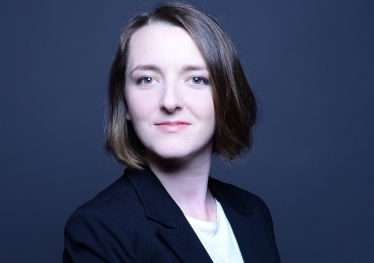HZB scientist got the dissertation prize at the spring conference of the Deutsche Physikalische Gesellschaft

Dr. Nele Thielemann-Kühn was awarded the Innomag Dissertation Award 2018. © Privat
Dr. Nele Thielemann-Kühn was awarded the dissertation prize of the magnetism research group at the spring conference of the Deutsche Physikalische Gesellschaft (German physical society/DPG) in Berlin. The prize is awarded for outstanding research in the field of magnetism.
Dr. Nele Thielemann-Kühn studied ultrafast magnetic dynamics in ferro- and antiferromagnetic dysprosium during her PhD work at the HZB and the University of Potsdam. Her dissertation, mentored at HZB by Dr. Christian Schüßler-Langeheine, included experiments with ultrashort X-ray pulses at BESSY II. She had already received the 2017 Ernst Eckhard Koch Prize for her dissertation and is now continuing research at Freie Universität Berlin.
Results have been published for example in Physical Review Letters (06 November 2017): Ultrafast and energy-efficient quenching of spin order: Antiferromagnetism beats ferromagnetism; Nele Thielemann-Kühn, Daniel Schick, Niko Pontius, Christoph Trabant, Rolf Mitzner, Karsten Holldack, Hartmut Zabel, Alexander Föhlisch, Christian Schüßler-Langeheine
DOI: 10.1103/PhysRevLett.119.197202
Highlighted as Focus story in "Physics": Quick Changes in Magnetic Materials
Web news to this publication: Future IT: Antiferromagnetic dysprosium reveals magnetic switching with less energy
red.
https://www.helmholtz-berlin.de/pubbin/news_seite?nid=14795;sprache=en
- Copy link
-
Battery research with the HZB X-ray microscope
New cathode materials are being developed to further increase the capacity of lithium batteries. Multilayer lithium-rich transition metal oxides (LRTMOs) offer particularly high energy density. However, their capacity decreases with each charging cycle due to structural and chemical changes. Using X-ray methods at BESSY II, teams from several Chinese research institutions have now investigated these changes for the first time with highest precision: at the unique X-ray microscope, they were able to observe morphological and structural developments on the nanometre scale and also clarify chemical changes.
-
BESSY II: New procedure for better thermoplastics
Bio-based thermoplastics are produced from renewable organic materials and can be recycled after use. Their resilience can be improved by blending bio-based thermoplastics with other thermoplastics. However, the interface between the materials in these blends sometimes requires enhancement to achieve optimal properties. A team from the Eindhoven University of Technology in the Netherlands has now investigated at BESSY II how a new process enables thermoplastic blends with a high interfacial strength to be made from two base materials: Images taken at the new nano station of the IRIS beamline showed that nanocrystalline layers form during the process, which increase material performance.
-
Martin Keller elected new president of the Helmholtz Association
The Helmholtz Association has appointed internationally respected US-based scientist Martin Keller as its new president. Her has lived in the United States for nearly three decades, during which he has held various scientific leadership roles at prominent institutions. Since 2015, Keller has directed the National Renewable Energy Laboratory (NREL) in Golden, Colorado. His term begins on 1.11. 2025.
